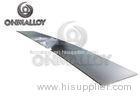1.6mm Hard Condition Fe Ni Mo alloy Vacuum Furnace 8.6g / cm3 Density
Ohmalloy 1J79 / Permalloy for Magnetic shielding
OhmAlloy-1J79 (Soft magnetic alloy)
(Common Name: Ni79Mo4, E11c, malloy, permalloy, 79HM)
Ohmalloy-1J79 is a nickel–iron magnetic alloy, with about 80% nickel and 20% iron content. Invented in 1914 by physicist Gustav Elmen at Bell Telephone Laboratories, it is notable for its very high magnetic permeability, which makes it useful as a magnetic core material in electrical and electronic equipment, and also in magnetic shielding to block magnetic fields. Commercial permalloy alloys typically have relative permeability of around 100,000, compared to several thousand for ordinary steel.
In addition to high permeability, its other magnetic properties are low coercivity, near zero magnetostriction, and significant anisotropic magnetoresistance. The low magnetostriction is critical for industrial applications, allowing it to be used in thin films where variable stresses would otherwise cause a ruinously large variation in magnetic properties. Permalloy's electrical resistivity can vary as much as 5% depending on the strength and the direction of an applied magnetic field. Permalloys typically have the face centered cubic crystal structure with a lattice constant of approximately 0.355 nm in the vicinity of a nickel concentration of 80%. A disadvantage of permalloy is that it is not very ductile or workable, so applications requiring elaborate shapes, such as magnetic shields, are made of other high permeability alloys such as mu metal. Permalloy is used in transformer laminations and magnetic recording heads.
Ohmalloy-1J79 widely used in radio-electronic industry, precision instruments, remote control and automatic control system.
Permalloy was initially developed in the early 20th century for inductive compensation of telegraph cables.When the first transatlantic submarine telegraph cables were laid in the 1860s, it was found that the long conductors caused distortion which reduced the maximum signalling speed to only 10–12 words per minute. The right conditions for transmitting signals through cables without distortion were first worked out mathematically in 1885 by Oliver Heaviside. It was proposed by Carl Emil Krarup in 1902 in Denmark that the cable could be compensated by wrapping it with iron wire, increasing the inductance and making it a loaded line to reduce distortion. However, iron did not have high enough permeability to compensate a transatlantic-length cable. After a prolonged search, permalloy was discovered in 1914 by Gustav Elmen of Bell Laboratories, who found it had higher permeability than silicon steel. Later, in 1923, he found its permeability could be greatly enhanced by heat treatment. A wrapping of permalloy tape could reportedly increase the signalling speed of a telegraph cable fourfold.
This method of cable compensation declined in the 1930s, but by World War 2 many other uses for Permalloy were found in the electronics industry.
Normal composition%
| Ni | 78.5~80.0 | Fe | Bal. | Mn | 0.6~1.1 | Si | 0.3~0.5 |
| Mo | 3.8~4.1 | Cu | ≤0.2 | ||||
| C | ≤0.03 | P | ≤0.02 | S | ≤0.02 |
Typical Mechanical properties
| Yield strength | Tensile Strength | Elongation |
| Mpa | Mpa | % |
| 980 | 1030 | 3~50 |
Typical Physical properties
| Density (g/cm3) | 8.6 |
| Electrical resistivity at 20(mm2/m) | 0.55 |
| Coefficient of linear expansion(20~200)X10-6/ | 10.3~11.5 |
| Saturation magnetostriction coefficient λθ/ 10-6 | 2.0 |
| Curie point Tc/ | 450 |
|
The magnetic properties of alloys with high permeability in weak fields |
|||||||
|
1J79 |
Initial permeability | Maximum permeability | Coercivity | Saturation magnetic induction intensity | |||
|
old-rolled strip/ sheet. Thickness, mm |
μ0.08/ (mH/m) | μm/ (mH/m) | Hc/ (A/m) | BS/ T | |||
| ≥ | ≤ | ||||||
| 0.01 mm | 17.5 | 87.5 | 5.6 |
0.75 |
|||
| 0.1~0.19 mm | 25.0 | 162.5 | 2.4 | ||||
| 0.2~0.34 mm | 28.0 | 225.0 | 1.6 | ||||
| 0.35~1.0 mm | 30.0 | 250.0 | 1.6 | ||||
| 1.1~2.5 mm | 27.5 | 225.0 | 1.6 | ||||
| 2.6~3.0 mm | 26.3 | 187.5 | 2.0 | ||||
| cold drawn wire | |||||||
|
Didn't find what you're looking for?
Post Buying Lead or
contact our customer service specialist for help!
| |||||||








